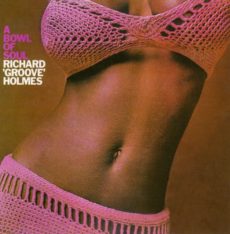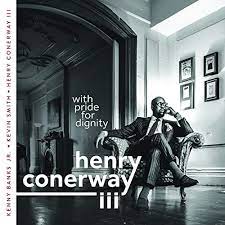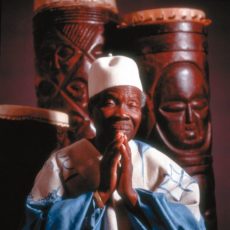
Requisites
Hammond B3 organist Richard “Groove” Holmes released his album A Bowl Of Soul in 1966 on the Valiant record label. The cover design was by Paul May. The session was produced by Nick Venet.
The original Soul-Jazz LP release seven compositions that featured four on Side A – A Bowl Of Soul, In The Dark, I’m Gonna Move To The Outskirts Of Town, Night Train, and on Side B – R.F.K. Flies Home, How Long How Long Blues and Roll ‘Em Pete.
An import CD reissue, of which this is the cover photo, includes the eight other songs that were recorded at the same sessions but not released. Blues For Big Fred, Please Send Me Someone To Love, Tobacco Road, See See Rider, Organ Grinder, I’d Rather Drink Muddy Water, Mean Old Frisco Blues and Your Red Wagon.
The album was the result of two sessions in March of 1964. The exact dates are unknown. Holmes was back on both sessions by an orchestra conducted and arranged by Onzy Matthews.
More Posts: choice,classic,collectible,collector,history,instrumental,jazz

Review: Henry Conerway III | With Pride For Dignity
Smile is what you do when hearing a compelling sound. That is exactly what I did when the first notes of the opening track filled the room. It takes a bassist to arrange a bassist’s composition and make it fresh.
Hailing from the Motor City, Henry Conerway honed his skills in the hallowed halls and practice rooms of Morehouse College as well as the stages of Atlanta clubs. This adroit but ever humble practitioner enlists two of the city’s finest jazz purveyors to accompany him on this sojourn through time – pianist Kenny Banks Jr. and bassist Kevin Smith. His musical acumen is steeped in the history and tradition of jazz, making his choice of compositions from the pantheon not so startling as he ventures through three generations of jazz masters and contemporaries – Ray Brown, Phineas Newborn, Duke Ellington, Jimmy Heath, Marcus Printup and Kenny Banks, Jr..
It is a well known fact that one should not take on a classic if one can bring nothing new to the canon and Ray Brown’s Slippery is one such composition. Conjuring up a myriad of thoughts as to what he may have been thinking when he composed this song, the trio puts its own spin while taking each listener on a personal sojourn with a new arrangement by Smith, raising the tempo ever so slightly to give it a fresh sound. The title track, With Pride For Dignity, composed by Banks begins quietly with a piano solo, that immediately put me in the revered mood of Danny Boy then quickly sent me to the equally reverent first line of New Orleans before stealthily moves through a series of jazz periods, giving one a sense of the pride and dignity of this recording session. Newborn’s composition Sugar Ray elicits thoughts of the great pugilist named Robinson, illustrating the grace and style with which he fought. Of course, with later generation the song could have meaning for Leonard or even Richard Pryor’s role in Harlem NIghts depending on perspective. His choice of the 1940 Ellington composition Cottontail, written for orchestra, deftly translates the emotion into a trio setting with all the tempo and panache a big band would express. Smith quickly walks the bass as he paces the music leading into the brush work of Conerway. I could have been in the Savoy Ballroom testifying to this performance as Jitterbuggers or Lindyhoppers paraded the floor.
Hopscotch by composer and irrepressible trumpeter Printup is not the stuff of school girls tossing stones and jumping in chalk-lined squares but exhibits a similar humor of adults reminiscing those sidewalks as the trio swings this one. Heath’s Gingerbread Boy proves that jazz is never easy and placing it among such revered company is the epitome of this talented threesome true to their character. Banks follows this with another of his compositions The Feel Goods with a short overture that leads into a hip swing that best exemplifies the best times of our lives. Conerway closes with Carvin’s Agreement, an original composition he penned to pay tribute to one of his teachers, Michael Carvin, showing us just what drums can do.
Conerway’s svelte delivery as a leader keeps him in stride with his compatriots who swing equally gentle or sassy when called upon. An inventive drummer, he carries each song with equal parts to his companions, never overshadowing the others. Having witnessed the growth of these young men over the years, they were satisfied on many an occasion to sit unnoticed in the audience while gleaning pointers from the masters, a practice few young musicians find a need to do in this day and age. Like all great musicians they also realize there is still much to learn, more growth to take place. So it is no surprise their evolution into this cohesive unit affords them the facility to ply their trade as well as they do. They are more than musicians, they are friends who can start, carry and finish each other’s musical conversation when required. However, I beseech you to not overlook the liner notes so eloquently written by esteemed saxophonist and professor Dwight Andrews. Also do not dismiss the cover photography of any album because there is always a story, one deeper that you may surmise. This photograph was decidedly taken upon Henry’s request during a visit to the home of Langston Hughes. Historic on many levels.
Much more cannot be said of this album other than this is not a quick listen to see if you like it. You will. So take note music directors and programmers, it is radio friendly. You don’t need to skip tracks without listening to each one fully. If you must skip tracks it is my hope that you have a favorite song on this project and anticipation of getting to it is unbearable to see the trio’s approach. Whatever you do, this album speaks for itself and is a testament to the volumes of knowledge these industry-respected practitioners have about the music they have given their lives to enjoy performing. This is with pride for dignity and well worth the nod from their peers and a well-deserved Grammy nomination from the Recording Academy. Listen. You will be pleased.
carl anthony | notorious jazz | november 17, 2018
Give A Gift Of Jazz ~ Share ![]()
#preserving genius
More Posts: bandleader,drums,history,instrumental,jazz,music,review

The Jazz Voyager
The Jazz Voyager is off to France, where the gypsy jazz of Django Reinhardt was popular in the 1930s, to Sunset/Sunside at 60 Rue des Lombards, 75001 Paris. This visit to the City of Lights will partake of the music of the guitar Gilad Hekselman Trio featuring Kendrick Scott and Nitai Hershkovits.
This family-owned club, created in 1983 by Michele and Jean-Marc Portet, has two rooms, each with a very different feel: Sunside looks like a 1950s New York jazz club while Sunset’s styling is reminiscent of the Paris metro.
Showtimes are 7:30 pm and 9:30 pm, admission is €30.00 and reservations are highly recommended at +33 (0) 1 40 26 46 60. #wannabewhereyouare #jazz #voyager #travel #club #adventure
More Posts: adventure,club,genius,jazz,museum,music,preserving,restaurant,travel,voyager

Three Wishes
Olatunji gave his single response to Nica by stating:
- “To be an artist.”
*Excerpt from Three Wishes: An Intimate Look at Jazz Greats – Complied and Photographed by Pannonica de Koenigswarter
More Posts: baroness,history,instrumental,jazz,musician,pannonica,three,wishes

Requisites
Stan Getz Plays is a compilation album of previously released material by tenor saxophonist Stan Getz recorded in 1952 but wasn’t released until 1955 on the Norgran label. The album, however, features tracks (1,3-12) that were previously released on two 10-inch LPs on Clef Records, (13-14) originally released on Verve, and (15 & 16) previously released on MGN. Tracks 12-16 were bonus tracks on the CD reissue.
Stella By Starlight, Time on My Hands, Tis Autumn, The Way You Look Tonight, Lover, Come Back to Me, Body and Soul, Stars Fell On Alabama, You Turned The Tables On Me, Thanks For The Memory, Hymn Of The Orient, These Foolish Things, How Deep Is The Ocean?, Nobody Else But Me, Down By The Sycamore Tree, I Hadn’t Anyone Till You and With The Wind And The Rain In Your Hair.
Recorded in New York City on December 12, 1952 (tracks 1-8) and December 29, 1952 (tracks 9-12). The Los Angeles, CA session was on January 23, 1954 (tracks 13-16). The album cover was designed by Tom Hughes and the photograph was taken by Phil Stern.
The personnel on these recording were: Stan Getz on tenor saxophone, with guitarist Jimmy Raney on tracks 1-12, pianists Duke Jordan on tracks 1-12 and Jimmy Rowles on tracks 13-16, Bill Crow on tracks 1-12 and Bob Whitlock on tracks 13-16 shared bass duties, and Frank Isola on tracks 1-12 and Max Roach on tracks 13-16 were the drummers.
More Posts: choice,classic,collectible,collector,history,instrumental,jazz




